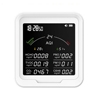An air quality monitor is a device designed to measure and display the concentration of various pollutants and particles in the air. It helps assess the overall quality of air in an indoor or outdoor environment by providing real-time data on the presence of contaminants that may affect health and comfort.
The primary role of an air quality monitor is to detect harmful substances such as particulate matter (PM2.5 and PM10), carbon dioxide (CO2), volatile organic compounds (VOC), ozone (O3), nitrogen dioxide (NO2), carbon monoxide (CO), and other pollutants. By providing this data, it helps users make informed decisions about improving air quality and reducing exposure to harmful substances.
The air quality monitor price list form tool.com. provides an overview of the various options available in the market, catering to different needs and budgets. Whether you're looking for a basic home monitor to track common pollutants like PM2.5 and CO2, or a more advanced industrial-grade device with multiple gas detection capabilities, this list helps you compare features, accuracy levels, and price ranges.
Air Quality Monitor Price List
Air Quality Monitor Working Principle
An air quality monitor operates by utilizing a combination of advanced sensor technologies to detect pollutants and particulate matter in the air, converting this data into usable information for users. The process can be understood in several main steps, each essential to the monitor’s functionality:
Air Intake and Sampling
Air quality monitors first draw ambient air into the device through an airflow mechanism, either using a small fan or passive air intake vents. The sampled air is then passed through the monitor’s sensors. Some models may include pre-filters to block larger particles like dust, ensuring that the sensors measure only the targeted pollutants. The filters do not alter the concentration of pollutants; they simply protect the sensors from damage or obstruction.
Sensor Technology
The core of any air quality monitor lies in its sensors, which detect and measure various pollutants. Different types of sensors are used depending on the specific pollutants being monitored:
Particulate Matter (PM) Sensors
For detecting particulate matter (PM2.5 and PM10), monitors typically use laser scattering technology. In this method, a laser beam is projected through the air sample, and when particles pass through it, they scatter the light. A photodetector captures the scattered light and translates it into electrical signals. The intensity of this scattered light is proportional to the number of particles in the air, allowing the device to estimate particulate concentration.
Gas Sensors
Different gases require different sensors:
- Electrochemical Sensors: These are used to detect gases like carbon monoxide (CO) and nitrogen dioxide (NO2). When a gas comes into contact with the sensor, it triggers a chemical reaction that produces an electric current. The strength of this current correlates with the concentration of the gas.
- NDIR Sensors (Non-Dispersive Infrared): These sensors measure gases like carbon dioxide (CO2). They work by passing infrared light through the air sample and measuring how much light is absorbed by the CO2 molecules.
- PID Sensors (Photoionization Detectors): Used to detect volatile organic compounds (VOCs), these sensors ionize gas molecules using ultraviolet light and measure the resulting current to determine VOC concentration.
Data Processing and Signal Conversion
Once the sensors detect pollutants, the data is converted from analog signals into digital form by an analog-to-digital converter (ADC) within the device. The raw sensor data is processed by the monitor’s internal algorithms, which compensate for factors like temperature, humidity, and sensor drift to ensure accurate readings. This processed data gives a clear picture of the air quality by calculating concentrations of pollutants such as PM2.5, CO2, or VOCs.
Display and Output
After processing the data, air quality monitors display real-time results on a screen. These results typically include pollutant concentrations, often with color-coded indicators to show the air quality level (e.g., green for good air quality, red for poor). More advanced models store historical data, allowing users to track trends over time. Many modern air quality monitors come equipped with Wi-Fi or Bluetooth connectivity, enabling data syncing with smartphones or computers via dedicated apps, providing insights, trends, and recommendations on improving air quality.
Alarms and Notifications
To alert users of dangerous air quality levels, air quality monitors often include visual and auditory alarms. If pollutant levels exceed predefined thresholds, these alarms notify users to take action. For smart home integration, some monitors send notifications directly to a smartphone, allowing users to monitor air quality remotely and respond quickly in case of hazardous conditions.










